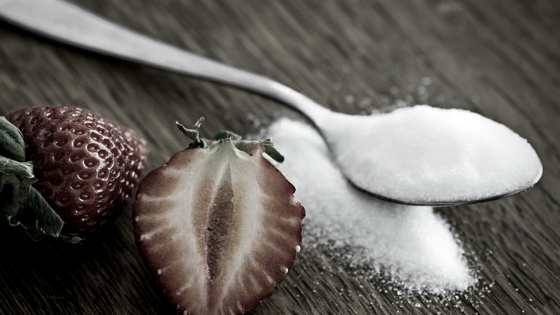There is a lot of fear these days regarding sugar intake and its role in long term health. High sugar intake has been implicated in the main diet-related chronic illnesses: type 2 diabetes, heart disease, cancer, and even Alzheimer’s.
This fear drives many diets out there to encourage minimizing or even completely eliminating sugar from the diet, including natural sources like fruits (fructose) and dairy (lactose). Grains also get lumped into this category, as the carbohydrate in grains gets broken down into the same basic unit sugars do: glucose.

As a nutrition professional I don’t believe sugar should be eliminated from the diet. It’s a surefire way to build cravings for it and overeating it later down the line. The body also requires glucose to run efficiently – particularly your brain and muscles. Well-timed sources of sugar can actually provide some benefit, as any endurance athlete will be quick to validate.
Here are a few guidelines to follow when making decisions about sugar so you don’t go overboard in either direction!
- Is it a natural source of sugar?
There are two main natural sources of sugar: fruit (fructose) and dairy (lactose). For dairy, there are typically about 12 grams of natural sugar per 8-ounce serving. Fruit varies greatly, but as an example there are about 19 grams of sugar in an apple, 17 grams in an orange, and 15 grams in a cup of blueberries. The average nutritional recommendation for dairy is 3 servings per day, and for fruit it’s 2 servings per day. If you stick to your general recommendations, that equals about 60-70 grams per day.This source of sugar comes packed with nutrients; for lactose, you’re also getting protein, calcium, and vitamin D — all of which are nutrients many Americans are looking to increase in their diets. For fruits, it’s micronutrients like potassium and folate, as well as fiber and protective antioxidants.
Eliminating these sources of natural sugar also eliminates all of the nutritional benefit that comes with it! Stick to and enjoy your dietary recommendations, and the natural sugars that come with them.

- Is it an artificially added sugar?
Any food product that has added sugar is required to list that in the ingredient list of the nutrition facts label. For example, any energy bar that does not have dairy or fruit will contain added sugar. Look to the ingredient list to identify the source. If the ingredient list includes “sugar,” and there are 18 grams of sugar in the bar, then all 18 of those grams are added sugar.The tricky thing here is that added sugars have many names. The more obvious will be sugar, honey, and maple syrup. Other forms of added sugar include agave, brown rice syrup, molasses, caramel, corn syrup, corn sugar, high fructose corn syrup, dextrose, fructose, maltose, lactose, sucrose, and nectars — to name a few!
If you want to evaluate your sugar intake for a week or two, pay attention to food labels, take note of grams of sugar per serving, and then check the ingredient list to see whether any sugar is added.
- Does it fall within my daily recommended guidelines for sugar intake?
The Dietary Guidelines recommend limiting added sugars to less than 10% of their total daily calories as part of a healthy diet. For the average 2,000 calorie diet this amounts to 200 calories, or 50 grams of sugar, per day. As a reference point, there are about 4 grams in a teaspoon of sugar, so that’s about 12 teaspoons of sugar per day.There are 2 ways to stay within your recommended sugar guidelines without completely eliminating it. First, stick to the recommended servings and portion sizes of dairy (3 per day) and fruit (2 per day). Second, read labels to determine amounts of sugar in a product, and whether there’s any added sugar in the ingredient list.
If the product contains dairy, subtract about 12 grams of sugar per serving to account for natural lactose. If the product contains fruit, subtract about 15 grams of sugar per serving to account for natural fructose. Whatever is left is considered added sugar. Try to limit that amount of added sugar to less than 50 grams per day and you’re armed with everything you need to know to navigate nutrition labels for sugar!





